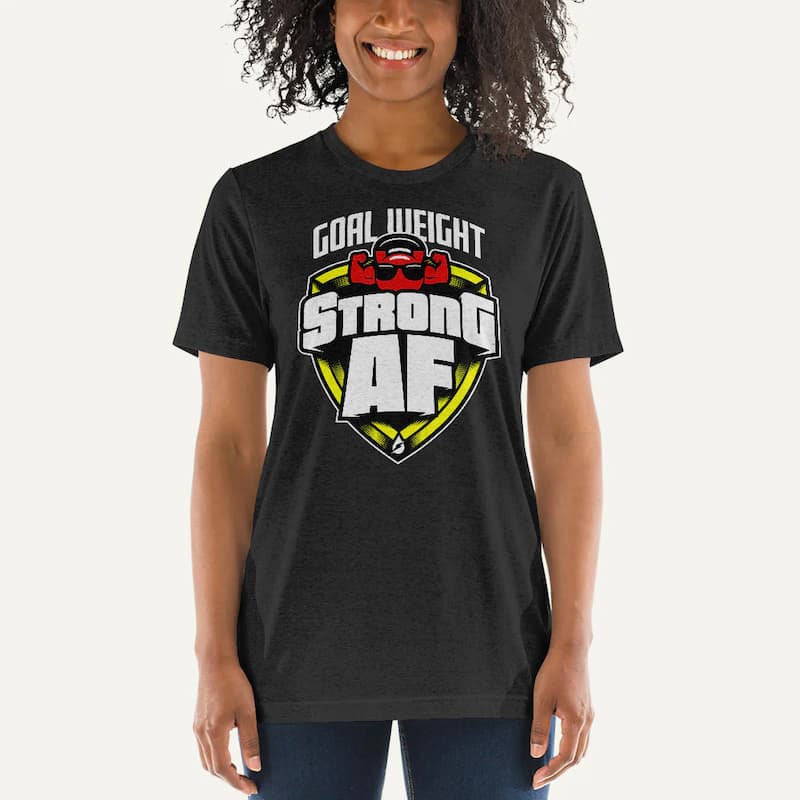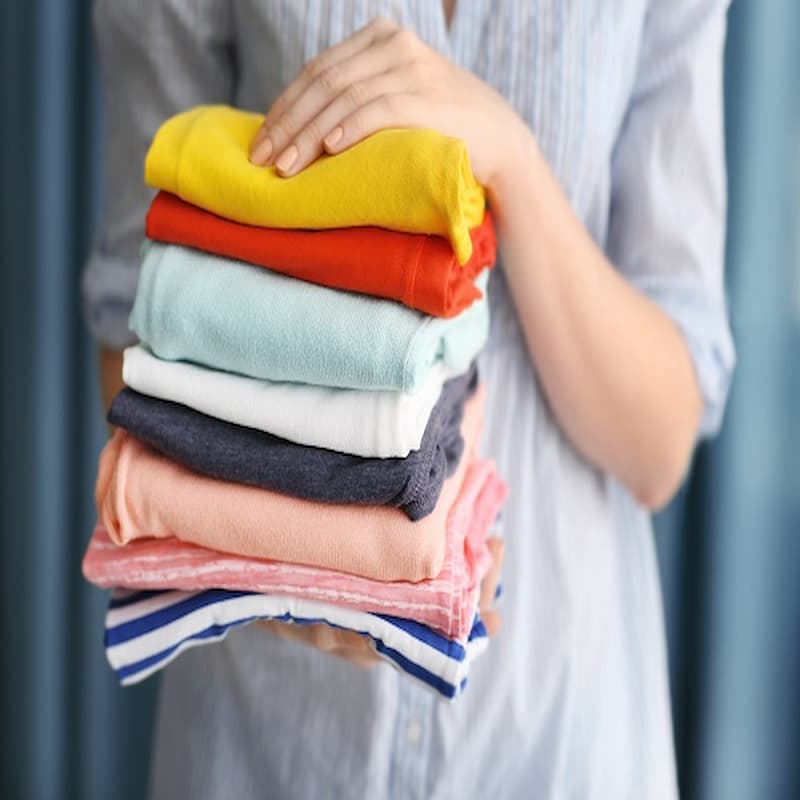How Much Do T-shirts Weigh? What Impacts Them
What does a t-shirt weigh? It’s a simple question, but the actual answer is more complex than you might think. T-shirts can have dramatically different weights depending on the fabric, size, and design elements used. If you’ve ever held two shirts side by side and noticed a difference in heft and feel, the explanation lies in the precise weight per square meter of fabric.
Understanding tee shirt weights matters for both buyers and sellers. As a buyer, tee weight impacts the comfort, durability, and even environmental impact of your purchase. And as an apparel company, choosing the right fabric density helps attract customers and keeps manufacturing and shipping costs in line.
In this in-depth guide to t-shirt weights, we’ll cover:
- The average weight for a medium cotton tee
- Weight ranges across common t-shirt fabrics
- What accounts for differences in shirt weights
- How to know if a shirt is lightweight, midweight or heavyweight
- The role weight plays in cost, sustainability, and wearability
So whether you’re just curious or want to make informed t-shirt decisions for business or pleasure, read on to uncover the precise weights behind one of humankind’s most ubiquitous garments.
How Much Does the Average T-Shirt Weigh?
Let’s start with a medium, the most common t-shirt size for American men. Made from 100% cotton in a classic crew or v-neck, a M-sized tee will tip the scales at 130-175 grams (4.6-6.2 oz).
That relatively narrow 50-gram range represents the standard medley of mainstream consumer shirts, including big box and budget brands, custom screen printing blanks, and better basics from casual menswear labels.
Within that bandwidth sit most men’s fashion tees hovering 150 grams while premium heavyweight crewnecks punch in at 175 grams. And on the light end at 130 grams, you’ll recognize the thinner offerings from fast fashion sellers and bulk pack multipacks.
So 130-175 grams makes up the medium cotton tee sweet spot. But drill down further across less common sizes, niche fabrics, embellished designs, and other factors and the weight spectrum expands dramatically.
To illustrate, let’s look at how finishing treatments and fabrication alone can double an average tee’s weight.

T-Shirt Weight By Fabric Type
Component threads and textiles define both functionality, feel and weighs. Here are the weight breakdowns across top apparel cottons and blends:
- Heavyweight Cotton – 200-300g
- Midweight/Standard 100% Cotton – 130-175g
- Lightweight Slub Cotton – 100-130g
- Tri-Blend (50% cotton, 25% polyester, 25% rayon) – 120-150g
- Polyester Athletic/Gym Tees – 100-150g
- Organic Cotton – 115-160g
- Preshrunk Cotton – 135-180g
- Cotton/Modal Blend – 130-160g
As you scan those numbers, two guideposts emerge:
- Heavier doesn’t necessarily mean higher quality: Heavyweight tees sacrifice softness for ruggedness. For casual everyday wear, most prefer lighter midweight cotton styles around 150 grams.
- Natural fibers usually outweigh synthetic ones: Pound for pound cotton packs more mass than moisture-wicking manmade microfibers. A 170 gram preshrunk cotton tee will feel fuller in the hand than a 150 gram polyester or polymer-cotton blended shirt.
And weight differentiation can be more pronounced moving into extremes like tissue weight tee shirts at 80 grams to triple-ply 350 gram heavy duty construction shirts.
But fiber content and processing just scratch the surface of the forces acting on finished t-shirt weights. Next let’s unpack the laundry list of design details that tip the scales up or down.
What Makes Some T-Shirts Weigh More Than Others?
From sewing techniques to branding and operational choices that stock warehouses, seemingly microscopic decisions stack up to noticeable differences in tee weights.
Here are some of the biggest factors:
1. T-Shirt Sizing
All else being equal, scale matters. Larger sized garments cut from oversized pattern blocks require more fabric yardage leading to elevated overall weights. Tall sizes involve more material vertically; double XL’s horizontally.
On average, you can expect men’s sizes to incrementally climb:
- Small: 120-165 grams
- Medium: 130-175 grams
- Large: 140-185 grams
- XL: 150-195 grams
As torso and sleeve circumference widen, an additional 10 grams gets tacked on up the ladder.
For context, child and women’s tees skew 20-30 grams lighter on the low end across comparable sizing.
2. Material Density and Features
Not all cotton gets created equal. Beyond long staple versus short staple yarn quality, processing variables like combing, strand thickness, ply counts, dye lots and more affect the meterage bulk weight called grams per square meter or GSM.
Generally speaking, the higher the GSM, the heavier and more durable the end garment. Premium tee shirts target a heavyweight 200 GSM knit while budget bulk packs can drop down to 120 GSM levels.
And that’s before specialized material treatments like…
- Brushed Fleece interiors that raise weights by 25 to 50 grams for extra softness.
- Enzyme Washes that break down fibers thinning fabric 5-15%
- Oversized Graphics that plaster multiple ink layers onto shirt bodies.
In many cases, the technical specs aren’t readily advertised for plain end-consumer tee shirts. But the next time you feel a substantially heavier shirt, chances are the GSM tells the tale.
3. Manufacturing and Sewing
Textile engineering processes influence weights as well. Pre-shrunk cottons undergo an initial compacting wash to remove excess sizing. And dense double needle stitching adds to the ledger over faster, looser sewing.
Even details like side seam construction play a role. Double-stitched hems require an extended seam allowance along the edges. That’s why you might notice slightly heavier shirts shifting around on your shoulders more than others.
4. Company Standardization
Material density only makes up one variable companies juggle designing commercial tee shirt lines.
Common weight target ranges balance consumer expectations with keeping overhead costs reasonable in areas like:
- Fabric yardage & cut and sew labour: Heavier shirts require more source material and longer production times.
- Packaging: Compressing overweight shirts risks distorting shapes.
- Inventory transport: Excess collective poundage drives up shipping expenditures.
- Retail packaging: Shelf cartons hold finite numbers of heavyweight shirts.
Without fixed tee shirt weights, projected profits and supply chain logistics get thrown out of whack.
As a general rule of thumb based on the above constraints…
- Startups and smaller brands aim lighter using 130-150 GSM fabrics
- Print shops and fulfilled merch platforms sit around 150-165 GSM
- Fashion basics labels print on 165-180 GSM midweight cotton tees
- Premium lines lean into 180+ GSM heavyweights
- Big box budget bundle packs drop into 100-120 GSM territory through every production shortcut imaginable.
But even juggernaut jersey knit manufacturers regularly churn out 130 to 170 gram mainstay shirts year over year for distribution efficiency.

How to Know If a T-Shirt Is Light, Mid, or Heavyweight
Okay, now that you know the intricate levers that inflate tee weights, how do you gauge a specific shirt without sending it to a lab for density diagnostics?
Here’s a basic 3-point checklist for quick at-home analysis:
1. Weigh It
Kitchen scales serve as handy readonly GSM detectors for tee shirts. Simply lay the garment flat and take an exact gram reading.
Compare your measurement against the defining lightweight, midweight and heavyweight ranges:
- Lightweight: Less than 130 grams
- Midweight: 130-175 grams
- Heavyweight: Over 200 grams
Remember that larger sizes trend heavier, so keep the sizing variable in mind.
And know that higher than expected pounds don’t automatically signal better quality if coming from overmanipulated heavy dye concentrates and binders.
2. Stretch and Sniff Test
Next, grab the shirt on its sides and gently pull outward while noting the neck hole and sleeve distortion. Lightweight fabrics should stretch 10-15% wider with ease while dense heavyweights barely budge.
Similarly, medium shirts require some strength to tear while tissue tees nearly fall apart of their own volition.
Finally, take a whiff inside the shirt. Heavyweight premium cottons exude that fluffy towel scent while cheaper synthetic blends give off a mass-produced chemical-like odor. Trust your senses.
3. Compare Physical Hangfeel
Lastly, hang the hanger hooked mystery shirt next to a known lightweight and heavyweight control sample. Let the three sway freely and watch how the fabrics fall and drape under gravitational forces.
Lightweights flutter and sink more readily while heavy cottons hold their structure. This analog test exposes density differences with a simple side-by-side visual check.
Unlock the secrets of compelling copy with ‘T-Shirt Business Description Examples: 5 Tips and Tricks for 2024‘. Read more now!
What Difference Does T-Shirt Weight Make for Buyers?
Now that we’ve broken down the grams hiding inside enigmatic t-shirt weights, what does it all mean for the average consumer? Should you actively seek heavy or light shirts?
Here’s an abridged buyers guide to tee weight considerations:
Comfort & Feel
Heavier is not inherently better for casual t-shirt wearability. Yes, big number GSM specs signal durable construction. But all that dense fiber mass leads to boardy rigidity, restricted movement, and discomfort over extended wears.
For a broken-in tee with that instant vintage softness right out of the package, a medium 150 GSM strikes an ideal balance.
Fit & Drape
Lighter and midweight fabricscontours to the body more naturally. Heavy shirts tend to pitch fabric tents off flat chests while refusing to smooth onto round bellies.
If maintaining a sharp silhouette matters, moderately weighted tees around 150 grams help fabrics fall just right. For looser oversized fits, heavier is fine.
Warm Weather Breathability
Come summer sweat sessions, low density shirts offer vastly improved ventilation and cooling airflow. Exercise gear companies manufacture specialty “breathable” fabrics exactly for this reason.
So while thick heavy cotton can better insulate during spring and fall, scale back the grams as temperatures climb to avoid a sauna effect.
Budget Considerations
T-shirt grading scales LINK mean cheaper manufacturing and thus reduced retail pricing on the low weight end. So that 6 pack licensed graphic tee bundle deal seems affordable for good reason – the actual material quality likely underperforms midrange options.
But no need to overspend on heavy tees either. Find the economical medium weight sweet spot between 130-160 GSM for value.
Environmental Impact
Assuming like-fiber fabric constructions, heavier cotton shirts consume more raw material inputs and accrued transport miles required to haul the excess mass. So lightweight and midweight tees generally leave a smaller carbon footprint.
Durability
This one’s simple – heavyweight shirts withstand more wears and tears over time thanks to their brawny innate damage resistance superpowers. Just know that reinforced long lasting fibers often tradeoff on plushness.
So those are the key considerations – from drape and comfort to sustainability – that tee shirt weights impact for buyers. Now let’s flip the script to see why weights warrant attention from business owners too.

Why T-Shirt Weight Matters for Sellers
We’ve covered why everyday t-shirt wearers might pay attention to fabric densities expressed in GSM and grams. But weights factor heavily on the supply side as well influencing production workflows and profit margins.
Here’s an overview what densities mean for apparel brands and shirt printers.
Manufacturing Minimums
Traditional cut and sew factory minimums hover around 1,000 units for custom runs. But setup charges based on unique fabric and color dye selections can raise startup costs exponentially.
Since lightweight and midweight cotton tees cost less per meter and simplify production workflows, those sweetheart 150 GSM baseline target weights help new brands test affordable small batch sampling.
Meeting Volume Demand
Fabric weight limitations constrain total available monthly production output. Heavier shirts mean knitters must spin longer yards of yarn and sew broader bolts of cloth to yield finished garments.
For tee printers running sales promotions or bands pressing merchandise for tours, targeting lighter base blank fabrics ensures warehouses can scale to demand. Because nothing leaves customers dissatisfied quite like inventory shortages and backorders.
Lower Per Unit Costs
Keeping shirt weights reasonable around 150 grams optimizes profits in cents. The math goes:
- Lower GSM = less fabric yardage needed per shirt
- Less yardage & sew time = dropped production costs
- Lower costs = expanded profit margins OR retail competitive pricing
Even minor 10-20 gram skews add up significantly at scale into the thousands. And remember those downstream shipping savings from lighter freight loads compound too.
Visual Brand Consistency
Standardizing label offerings by fixed fabric GSM regulates potential distortion issues. Ever order the same shirt twice and receive bags that somehow…feel different?
By locking in set material densities, apparel sellers safeguard against noticeable fluctuations in visual branding. Customers expect reliable consistency from their favorite brand’s classic tees year after year.

Weighing Core Considerations for T-Shirt Brands & Buyers
We’ve covered a ton of ground exploring the underlying forces that shape tee shirt weights. Here are the key takeaways:
- The average medium cotton t-shirt weighs between 130 and 175 grams. Going lighter or heavier depends on seasonal climate needs and personal comfort preferences.
- Density and fabric quality play a major role in dictating weights. But sizes, treatments, manufacturing methods and business considerations steer the scale too.
- Knowing whether a shirt falls on the lightweight, midweight or heavyweight spectrum is as easy as whipping out kitchen scales, giving a stretch test or comparing shirt drape side-by-side.
- Benefits for buyers range from wearability and budget to environmental impact and durability. Meanwhile apparel brands focus on balancing production volumes, cost controls and branding.
- When in doubt, it’s hard to go wrong landing around 150 grams for high value, high quality medium cotton tees suited for printing, embellishing and selling.
So next time you crack open a pack of plain blank tees or step up to shop indie band merch tables, put this intel to work. Let precise t-shirt weights inform both your purchases and projects as either everyday consumer or aspiring apparel entrepreneur.
The knowledge truly weighs in favor of savvy shirts!
